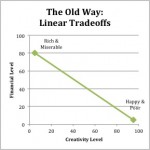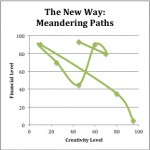April 22, 2013 • Events & Media
Genevieve Smith in a beautifully written essay, I’m for Sale, for Elle earlier this month expressed the angst that many of my students, clients, and colleagues express daily. She recalls her own personal challenges in balancing income against creativity and shares her father’s struggles with the same challenges a generation ago.
Things change. Technology empowers creative entrepreneurs in new and exciting ways. Opportunities that once seemed distant geographically are closer than ever, even for those outside of traditional hubs of creativity and innovation, artistic pursuits and achieved dreams. Domestic roles are no longer prescribed paths but rather conversation starters for all of us who envision partnerships and partners that help us achieve our personal and professional goals, whatever they may be. (And we help them achieve theirs too, by the way.)
These changes differentiate Smith’s experiences from her father’s. Things change. And yet they don’t. Both Smith and her father wrestled with the idea of balancing financial security and creative liberty. Both navigated their own paths and presumably found fulfillment along the way, although “fulfillment” may have been defined differently for each.
In fact, “fulfillment” may have been defined differently along the way.
Smith muses that as her career progressed and her life unfolded her desires changed. She found herself craving different things at 32 than she did at 22.
Things change.
In Arts & Numbers, I illustrate this point with a Happiness Graph.  It starts with a straight line illustrating the perceived linear tradeoffs between financial security and creative liberty. Those with financial security must be bereft of creativity, and those who pursue creative paths must struggle financially.
It starts with a straight line illustrating the perceived linear tradeoffs between financial security and creative liberty. Those with financial security must be bereft of creativity, and those who pursue creative paths must struggle financially.
Despite all that has changed in our world, sometimes we still limit ourselves to this dated idea of the tradeoff between financial security and creative liberty. We still romanticize the idea of a “starving artist” and justify our shortcomings by our choices.
- “I’d be able to afford to have a child if I worked in finance.”
- “I’d hate my life less if I had gone to design school.”
News flash: Things change. And yet they don’t.
The self-awareness and self-reflection that empowers us to choose fields of study, first apartments, a hitchhiking trip, and mismatched furniture is the same self-awareness and self-reflection that allows us to change our minds later. We can pursue modified fields of study, move to new dwellings as our lives unfold, travel to find ourselves (though perhaps not in strangers’ cars), and invest in furniture that tells a story of growth.
As we continue to chart our own paths, we learn that the Happiness Graph isn’t linear at all, and neither are our lives. There is not necessarily a tradeoff between creative liberty and financial security. It isn’t a binary choice in which one necessitates the absence of the other.
Things have changed.
In Smith’s article, Emily Gould described a 70/30 split where 70% of her time was spent doing what she loved and 30% was spent otherwise engaged (presumably for financial purposes). I’m sure that’s an idea that many creative entrepreneurs can embrace, but I like to think of it a little differently (and with fewer numbers, believe it or not).
I like to think of my professional life as a portfolio career. Just as an artist’s portfolio may be filled with many different pieces that fulfill (or fulfilled) different needs at different times, so to is a portfolio career. We each have a starring role, something we love (Gould’s 70% work). But we also have supporting cast roles that support the starring role, generally in related fields. They help us further our starring role and its opportunities, but they aren’t exactly what we’d like to be doing. Then we may have production assistance roles (Gould’s 30% work). They are necessary to sustaining financial security and a long-term creative career, but they aren’t how we’d choose to spend our time.
Except that they are. By choosing to build a career that involves some production assistance work, some supporting cast roles, and a starring role we empower ourselves. We’ve defined our choices in the context of something we love (our starring role), and we’ve changed our perception of those choices (and the rest of the work).
 Things change. As our cash reserve and financial security improves, we can devote less of ourselves to production assistance work and more of ourselves to supporting and starring roles. But as our needs change, we may decide to modify the path and focus more on the production assistance work if our lives demand it.
Things change. As our cash reserve and financial security improves, we can devote less of ourselves to production assistance work and more of ourselves to supporting and starring roles. But as our needs change, we may decide to modify the path and focus more on the production assistance work if our lives demand it.
And that’s okay.
The journey to find balance in life, whether it is between work and family, creative liberty and financial security, or simply professional achievement and personal fulfillment, is a meandering one.
Things change. Our journey may change. Our destination may change. But we humans always seem to enjoy the ride. And luckily, that doesn’t change.


